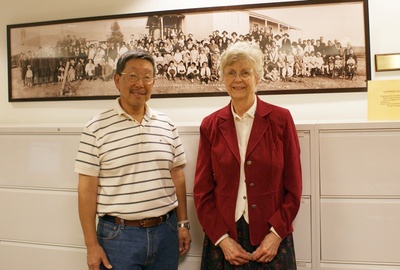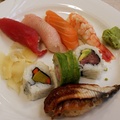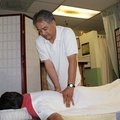Local library traces the history of 40 families through a commemorative photo of Japanese immigrants living in Palos Verdes at the beginning of the 20th Century
“Looking at the photo, I wondered who these people were. Who are they? Who are their families? I wondered if we couldn’t piece it all together.”
So thought Marjeanne Blinn, a Palos Verdes Library District librarian, as she looked at a photo of Japanese American families on the wall of the Local History Room where she works.
The caption below the photo—written in Japanese—says “Photo commemorating the inauguration of the agricultural union hall in the port of San Pedro, California, United States of America. Year 12 of the Taisho Era, November 24.” Taken to celebrate the opening of the Japanese American agricultural union facility in the southern part of the Palos Verdes peninsula, the photo was apparently taken on November 24, 1923. Counting all the men, women, and children, 187 people are pictured. Being involved in farming, every face is tanned. Almost everyone is Japanese or Japanese American, but, in the center, you can see three Caucasians. Later investigation revealed they were missionaries.
Before getting into Blinn’s story, let’s discuss Palos Verdes and Japanese immigrants. Part of the Los Angeles County, Palos Verdes is a peninsula southwest of downtown LA. A scenic spot with good weather, it’s a high-end residential area with many affluent Caucasians. Because it’s close to the South Bay, where many Japanese companies have been established, Japanese residents with the means to do so also live there. (In becoming such an upscale area, it may be out of reach for ordinary company employees…)
However, long before Japanese companies were established in Los Angeles, did you know that from the beginning of the 20th century, immigrants from Japan lived in the virtually undeveloped Palos Verdes peninsula? At that time, for immigrants who didn’t speak the local language, agriculture was the quickest route to earning a living. They rented land from American landowners and began farming. The crops made by immigrants began arriving on kitchen tables throughout Los Angeles—tomatoes, celery, chickpeas. Because it was an era without cars, at harvest time crops had to be taken downtown by horse-drawn wagons. Most of the people living in Palos Verdes at that time were Japanese Americans, but there were also Japanese farmers that hired Mexican immigrants as laborers.
When talking about the history of Palos Verdes, it’s impossible to ignore the existence of Japanese Americans. Sadly, however, there have often been times when the role of Japanese Americans has been left out of the local history. Blinn’s project focuses on these “lost and forgotten” pieces of hometown history. With volunteer help from Japanese American Richard Kawasaki, she started looking into the 40 families. But while listening to the stories of the descendants of the Japanese immigrants, they soon realized it would be a waste if all they did was uncover just the names of the people in the photo. They decided to gather the stories descendants told of the Japanese immigrants, and thus began the “40 Families History Project.”
They started by having an open house at the library, where they invited local Japanese Americans to look at the photo. “This person might be my grandpa.” As they started to gather the names bit by bit, they were visited by a certain Japanese American. After hearing about the project, Matsuo Hirose went to the library to see the photo. At the time of the photo, Hirose’s family owned a farm in the southern part of Palos Verdes. The photo didn’t include a shot of Hirose as a child, but his father was clearly featured. Plus, Hirose was able to reel in memories of people who lived in the neighborhood to put names to several of the faces.
As Richard gathered stories about the immigrants, he heard how Japanese American crops, especially tomatoes, were highly regarded. “Furthermore, when you planted the tomatoes, you gave it one cup of water and then you were done. After that, it was said the rain and ocean mist gave the plants all the water they needed. And here’s another story. Italian fishermen were living in San Pedro, and tomatoes were essential to their diet. So they traded their fish for the delicious tomatoes of the Japanese Americans.”
Blinn and her team weren’t just waiting for information to come to them. They gathered historical records from that time period on Japanese Americans across all parts of the country, looking for any trace of people having lived in Palos Verdes. Starting with residential maps created by the FBI, they also checked for information on Japanese Americans from materials of that era held at UC Berkeley, the national census from the 1920s and 30s, and the records of foreign resident registrations in the National Archives. Gathering contemporary records on Japanese Americans from all these places, they’ve been deducing the names of the 40 families. So far, they’ve identified about 25 families. The project name is “40 Families”, but based on the number of Japanese Americans at the time, they’re guessing that the photo actually includes 50–60 families (households).
It’s been five years since the project started—tracing the histories of Japanese immigrants is not easy. In addition to the fact that immigrants move around quite a bit, after Pearl Harbor (1941) the transfer of Japanese Americans to internment camps is certainly a key reason few descendants of the Japanese immigrants of the time are still in Palos Verdes today. Even before the official announcement of the order to relocate people of foreign enemy ancestry (Executive Order 9066), based on deteriorating feelings towards the Japanese, the landowners who had leased their land to Japanese Americans now evicted them. Forced to leave before the harvest, the Japanese Americans were then sent to internment camps.
In time, the post-war era began. While they were now free once again, the Japanese Americans that returned to Palos Verdes numbered a mere five families. According to Richard: “At that time, Japanese Americans had lost interest in farming. This was because the children had grown up and gone off to college. While there were no jobs (due to discrimination), many Japanese Americans preferred living in the more urban South Bay area.” Also, we can’t deny the fact that, after the war, anti-Japanese feelings among the landowners remained and Japanese Americans weren’t welcomed back to Palos Verdes.
To recall the “lost and forgotten” local history, Blinn and her team team plan on continuing their research. The National Archives is set to send any new records on Japanese Americans, and perhaps one person will once again discover some Japanese American history. As the data is gathered, it’s being organized and stored at the library—one family at a time. Blinn hopes that “the descendants of Japanese immigrants who ran farms in Palos Verdes will come visit us. I’d like them to open the folders and get a sense of what their ancestors did.”
* * *
For more information on the “40 Families History Project,” visit http://www.40families.org/. New information is accepted anytime.
Peninsula Center Library:
PVLD Local History Department
(310) 377-9584 ext. 213
Local History Room Hours:
Mon - Thurs: 10-4pm
Fri: 1-4pm
Sat: 10-1pm
© 2010 Yumiko Hashimoto







